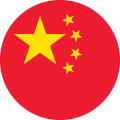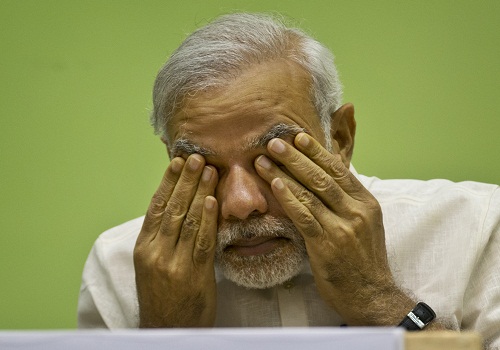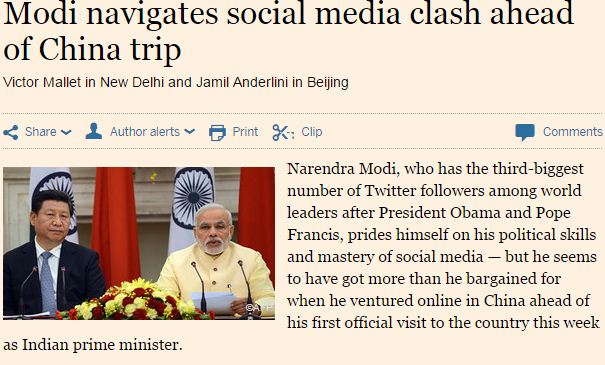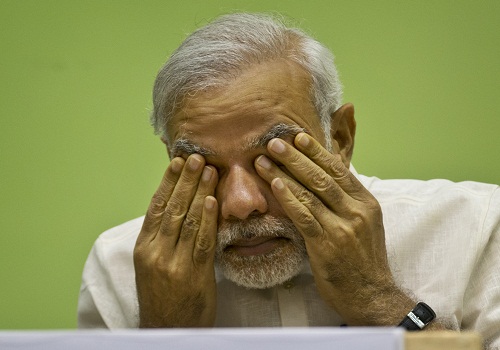 이미지 확대보기
이미지 확대보기파이낸셜 타임스에 따르면 모디 총리는 14일의 중국 국빈 방문에 즈음하여 중국의 트위터격인 웨이보에 "안녕하세요. 중국 친구들과 교류하길 기대합니다"라고 인사 글을 올렸다는 것.
여기에 돌아온 대답은 그대로 옮기기도 민망한 충격적인 것이었다고 이 신문은 전했다.
그 중에서도 가관인 것은 "인도는 중국의 개"라며 강아지 이모티콘을 붙여 놓은 것.
답변 중에는 엄연한 인도의 영토를 가리켜 "남 티베트는 중국 것, 되돌려 달라"는 도발도 있었다.
그들이 말하는 남티베트는 인도 동북부의 아루나찰 프라데시 주이다.
그뿐 아니다.
“우리한테 커리를 사주면 친구가 돼 줄게”라는 천박한 글도 있었다.
모디 총리는 소셜 미디어에 관한 한 세계 최고라고 자부하는 정치인이다.
트위터 팔로우도 세계에서 세 번째로 많다. 버락 오바마 미국 대통령과 프란치스코 교황 다음이다.
파이낸설 타임스는 중국인들이 모디 총리에 대해 이처럼 반감을 표명하는 데에는 나름의 사연이 있을 수 있다고 분석했다.
모디 총리가 중국에서는 반체제 인사인 티베트 망명 정부 관계자들을 초청한 데 대한 반감이 작용할 수 있다는 것이다.
또 중국의 남중국해 영유권 주장을 반대한 것도 원한을 갖게 된 한 요인이라고 이 신문은 지적했다.
그런 점을 감안하더라도 중국 네티즌들의 인도 모리총리에 대한 악의적 인사 글은 정도를 넘어섰다는 것이 일반적인 시각이다.
대국 중국의 참으로 대국답지않은 모습이다.
[다음은 인도의 모디 총리와 중국 네티즌 간에 웨이보 설전을 다룬 파이낸셜타임스의 보도 전문]
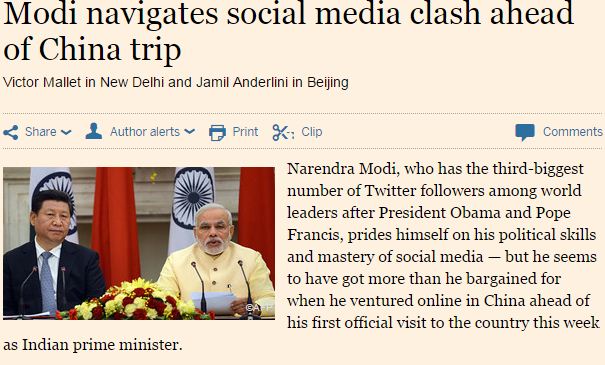 이미지 확대보기
이미지 확대보기Modi navigates social media clash ahead of China trip
Victor Mallet in New Delhi and Jamil Anderlini in Beijing
Narendra Modi, who has the third-biggest number of Twitter followers among world leaders after President Obama and Pope Francis, prides himself on his political skills and mastery of social media — but he seems to have got more than he bargained for when he ventured online in China ahead of his first official visit to the country this week as Indian prime minister.
Most responses from Chinese netizens to his sortie on the Twitter-like Weibo site were critical, derogatory or even racist, and most referred to a territorial dispute between the two countries over the Indian state of Arunachal Pradesh, which China calls “South Tibet”.
“South Tibet belongs to China, give it back,” was a typical comment after he sent his first Chinese post, saying “Hello China! Looking forward to interacting with Chinese friends through Weibo”. Other comments were less polite. “India is China’s dog,” said one, using a cartoon dog emoticon. “We’ll be your [Weibo] fans if you buy us some curry,” read another.
Perhaps Mr Modi, whose Hindu nationalist supporters can be equally vociferous and insulting about China or the west, should not have been surprised.
From the moment he came to power a year ago and infuriated Beijing by inviting the head of the Tibetan government in exile to his inauguration, he has made a point of standing up to China, India’s powerful neighbour across the Himalayas.
He went on to make a thinly veiled attack on Chinese expansionism while on a trip to Tokyo and took another dig at Beijing’s maritime claims when he joined President Obama in demanding freedom of navigation “especially in the South China Sea”.
But there is no disguising the fact that India is very much the weaker of the two nations, militarily and commercially, and officials on both sides expect Mr Modi’s meetings with President Xi Jinping — in public, at least — to focus more on economic co-operation and attracting $20bn of promised Chinese investment to India than on trying to end strategic rivalry in Asia or solve the dispute over their 4,000km border.
“There are many important bilateral issues — from territorial disputes to the Dalai Lama and Chinese submarine sales to Pakistan — but none of them can be resolved with such visits,” said Shen Dingli, Associate Dean of the Institute of International Studies at Fudan University in Shanghai.
I look forward to you quickly acclimatising to the foul wind and blood-drenched rain of Weibo and I look forward to communicating with you!
- Weibo user to Narendra Modi, India’s PM
“There is vast potential in trade, tourism, student exchanges, education, science, medicine, technology and sports . . . India should be gracious by being tolerant over China’s unwillingness to accept Arunachal Pradesh and China has to be realistic: India has nuclear weapons, so what can we do?”
Indian foreign policy experts recall the way Mr Xi’s supposedly friendly visit to India last year — he started in Mr Modi’s home state of Gujarat, just as Mr Modi will head first to Mr Xi’s Shaanxi province before going to Beijing and Shanghai — was overshadowed by an incursion by hundreds of Chinese troops across the disputed “Line of Actual Control” in the Himalayas.
Shyam Saran, a former Indian foreign secretary who chairs the Research and Information System for Developing Countries, said China had hardened its stance on the border dispute in recent years and was not in the mood for concessions.
 이미지 확대보기
이미지 확대보기“The most you can hope for is confidence-building measures, so that the border does not become a live issue,” he said. “The challenge of China for India has become far more complex. For the last couple of years there’s a greater sense of self-confidence and assurance that the Chinese have been displaying . . . We are facing a situation of growing asymmetry between the two sides.”
India finally seems poised to overtake China’s in terms of annual growth. But its economy remains a fraction of the size and it is just one of many developing countries in search of Chinese funding and expertise for infrastructure.
Under Mr Modi, India has arguably been more successful in foreign policy than in the expected reforms to the domestic economy. His administration has sought to repair relations with most of India’s south Asian neighbours, sending rapid aid to Nepal’s earthquake victims, approving a border rationalisation deal with Bangladesh and supporting the political coalition that ousted the pro-Chinese Rajapaksa government in Sri Lanka.
New Delhi, however, cannot hope to match the financial clout of Beijing, which recently promised $45bn in infrastructure investment to India’s rival Pakistan. Mr Modi, who will also visit Mongolia and South Korea, is therefore likely to attempt to improve India’s commercial ties with China while avoiding inflammatory controversies about the frontier.
Whether he will be allowed to do so by his new followers on Weibo is another matter. “I look forward to you quickly acclimatising to the foul wind and blood-drenched rain of Weibo and I look forward to communicating with you!” said one user.
김대호 연구소 소장 tiger8280@





